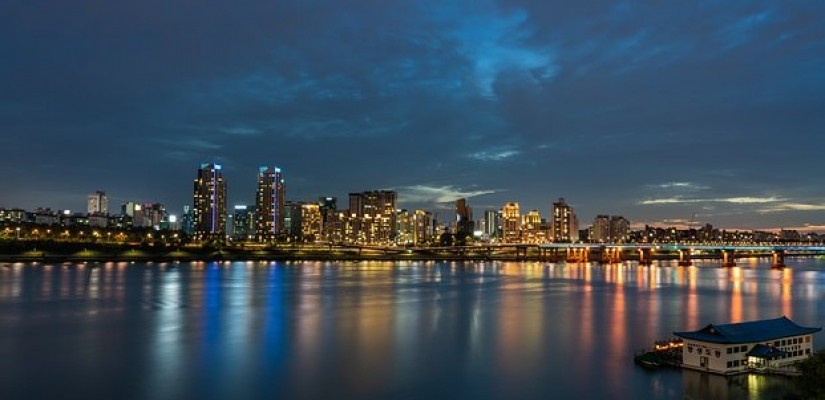As the impacts of climate change compound, emissions-free energy alternatives have gained traction around the globe. The solar energy market, for instance, is growing in many parts of the world, including India, China, Japan, Morocco, Germany, and the US. One energy alternative that has not yet gained as much attention as solar energy is hydrogen power. Still nascent, hydrogen energy has yet to prove itself as a competitor in the global sustainable energy market. South Korea plans to change this by developing and promoting hydrogen as a viable energy source. Expanding the hydrogen market will pose numerous challenges, such as the sourcing of clean energy for hydrogen fuel cells, government subsidies, and the installation of sufficient fuel stations. Responding to these challenges, South Korea’s government has laid out a roadmap for the growth of hydrogen energy domestically.
The Hydrogen Cities Project
South Korean officials announced that they will build three cities by 2022 that will be powered by hydrogen energy. The government is currently awaiting approval from residents to construct these cities and distributing incentives and benefits for residents to further the hydrogen cities project. The central focus of the initiative is to create an infrastructure that is based on hydrogen energy. In order to achieve this, South Korea aims to provide 9.9-megawatt fuel cells and commence the operation of 670 hydrogen passenger vehicles and 30 hydrogen buses. This fits into the government’s larger goal of transforming 10% of the country’s cities, counties, and towns into hydrogen-powered locations by 2030. South Korea’s subsequent step will be to increase this rate to approximately 30% by 2040.
Hydrogen Vehicles Outlook
A central component of the hydrogen energy initiative in South Korea is the operation of hydrogen-based vehicles. President Moon Jae-in announced that the government seeks to raise the number of hydrogen vehicles on South Korea’s roads to roughly 850,000 by 2030. Moreover, South Korea plans to produce 6.2 million hydrogen cars and build 1,200 fuel stations across the country by 2040. While this is an opportunity for car manufacturers, it is also a challenge since only about 3,000 hydrogen cars have been sold in the country so far. This is largely due to a lack of infrastructure. In order to boost hydrogen vehicle sales, the number of hydrogen fuel stations must also increase.

Producing Hydrogen Energy from Clean Sources
While hydrogen can be used to generate clean energy, much of today’s hydrogen energy is produced using fossil fuels that emit greenhouse gases and contribute to climate change. The South Korean government is combating this issue by looking for cleaner alternatives. The South Korean Ministry of Maritime Affairs and Fisheries has been working on developing a ‘bio-hydrogen production technology’ during the last 10 years. Scientists discovered a way to convert the pollutant carbon monoxide into hydrogen using deep-sea microorganisms. On November 5, 2019, it was confirmed that a bio-hydrogen power plant had been built in Taean, roughly 150km southwest of Seoul. The plant is operated by Korea Western Power Co., Ltd., a subsidiary of South Korea’s state-owned energy utility Korea Electric Power Corp. (KEPCO). The facility in Taean will produce about 330 tons of hydrogen a year, which can fuel about 2,200 vehicles annually. Over the course of the next six months, KEPCO will continuously run the facility in order to test its economic viability and safety. If the project is successful, South Korea may construct additional power plants in order to meet its hydrogen energy goal.
Hydrogen Market Opportunities and Risks
By establishing a fund of $1.8 billion, the South Korean government is creating incentives for businesses to stimulate the growth of the hydrogen market. The fund will subsidize car sales and the construction of fuel stations until 2022. Providing financial support to fuel station operators is crucial as they struggle to create revenue. Operating costs cannot be sufficiently covered without government subsidies because the government has set fuel retail prices low to attract customers. Furthermore, refueling equipment can only service a limited number of vehicles per day, which also curbs revenue. The government, however, has made efforts to subsidize hydrogen car production, reducing the price of Hyundai’s Nexo SUV by half to about $29,300. While this can be viewed as an investment opportunity, critics argue that the government mostly focuses on supporting car manufacturer Hyundai. Hyundai, however, will invest around $6.5 billion in hydrogen research, development, and facilities in turn by 2030. This indicates that market opportunities can be found in hydrogen research and facility construction, offering incentives to hydrogen technology developers, fuel cell suppliers, and fuel station construction companies.
Conclusion: A Momentum for Hydrogen Energy?
South Korea’s large-scale investment in hydrogen energy does not guarantee success, since the global hydrogen market is relatively small at present. Furthermore, a representative of Hyundai warns that building hydrogen car production facilities, supply chains, and sales networks can incur risks. Yet growing concerns about the effects of climate change have created awareness about alternative, clean energy solutions. Numerous state governments seek to foster their emission-free energy industries. This creates an environment that facilitates the growth of alternative energy solutions, giving hydrogen produced from emission-free sources the opportunity to gain momentum. Therefore, South Korea’s hydrogen energy initiative could render it a leader in the race for hydrogen power and yield successes in the long term.
